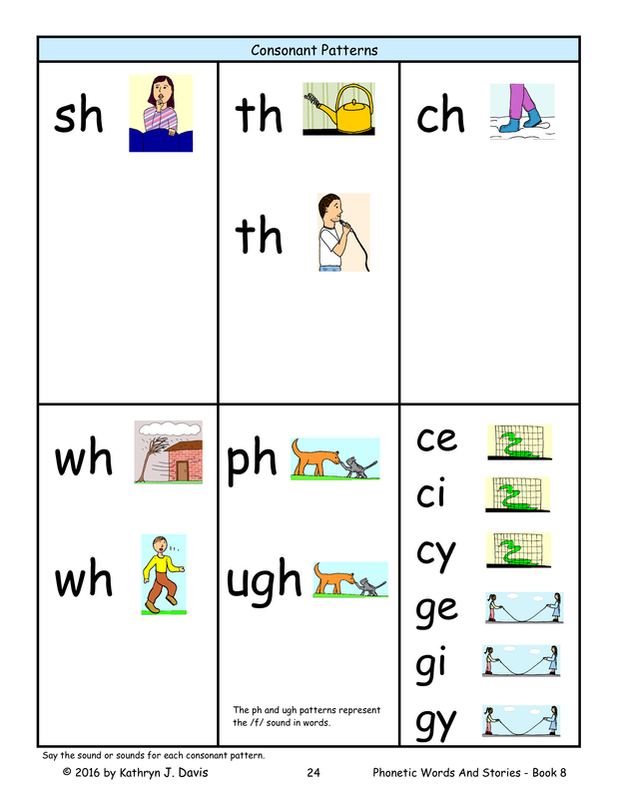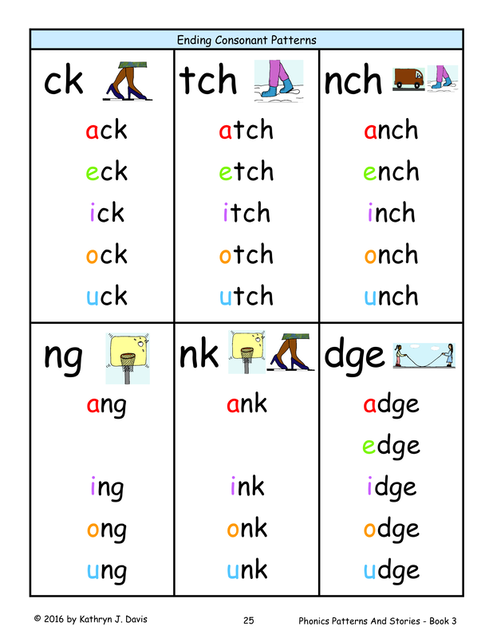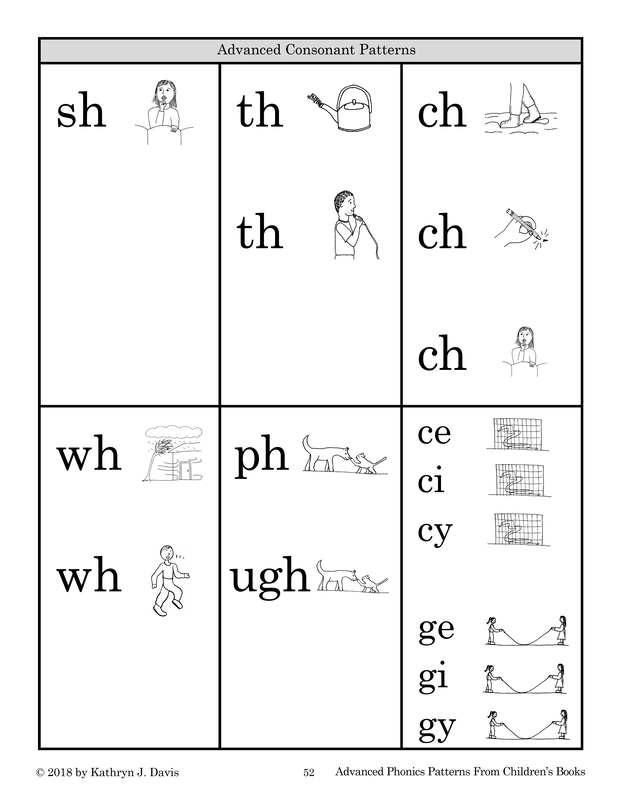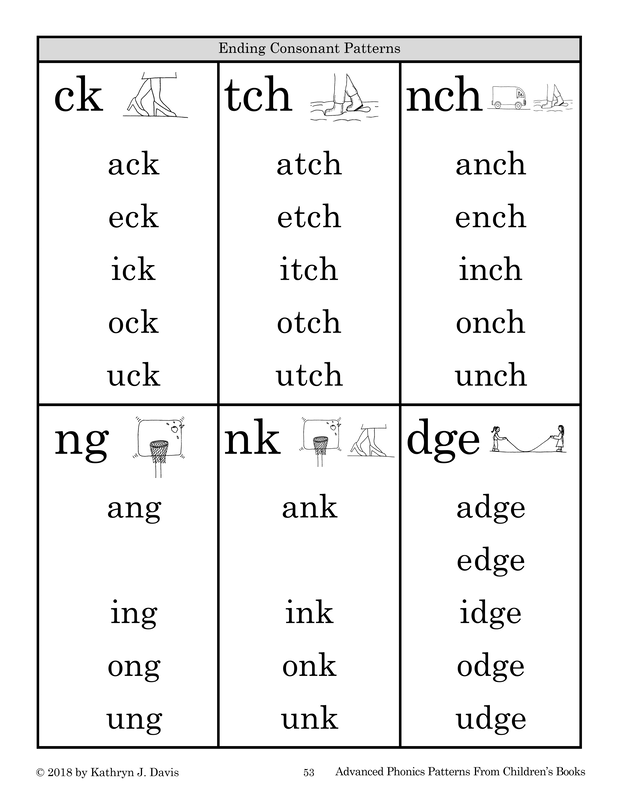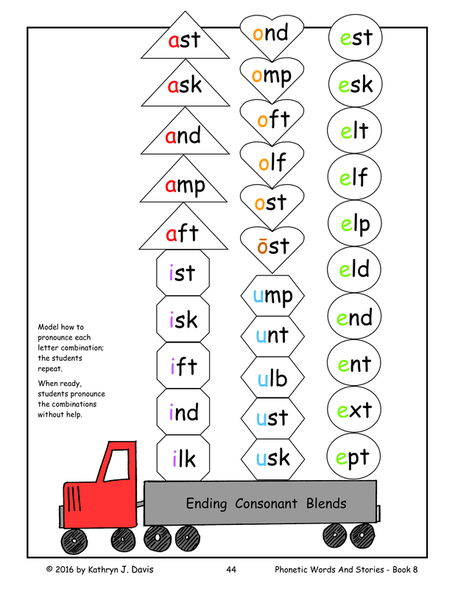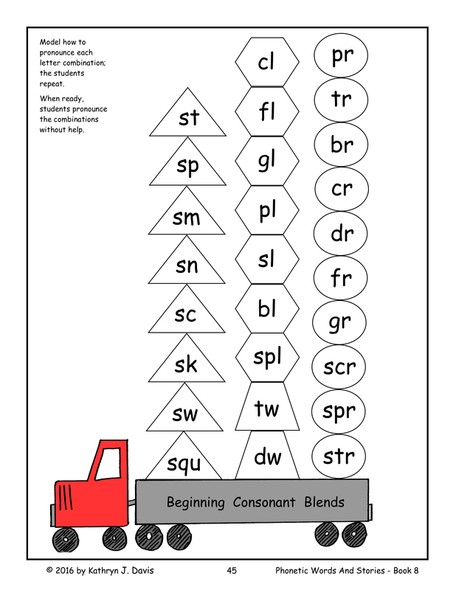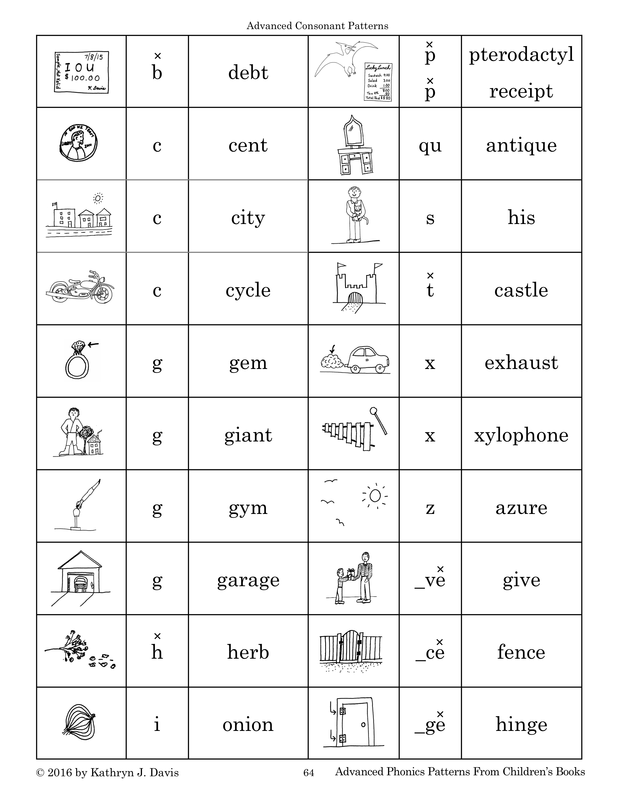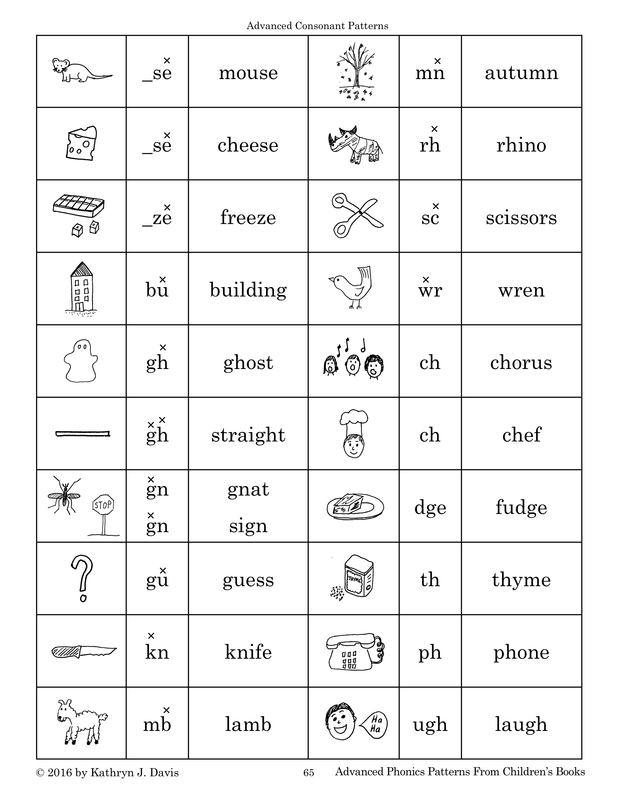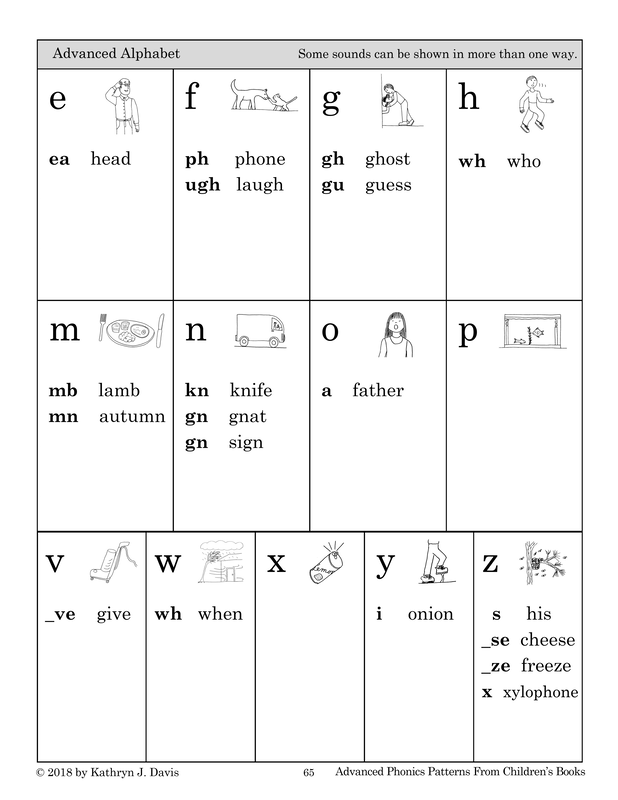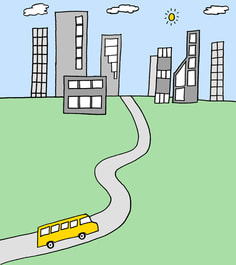Understanding ConsonantsConsonants are easier to understand than vowels, but there are still several things to learn about them. Most of the time, a single consonant represents a single sound. There are a few common two- and three-letter consonant patterns that are easy to learn. Two consonants (c and g) can represent a second, different sound (s and j, respectively). There are some other consonant variations but they are much less common, so it is not necessary to learn them right away.
Why are there so many different consonant patterns? It is because many words from other languages have been brought into the English language.
To hear the consonant sounds, listen to the sound story and sound charts under the audio and video menu headings.
Don't be discouraged by the number of different consonant patterns. Most consonants represent their usual sound in words. The variations will be taught in an orderly fashion and explained thoroughly as you work through this program. Many of these patterns are uncommon and are not taught until the advanced phonics patterns level. If you are not familiar with them, you will learn them along with the children.
|
Consonant Sounds
- There are twenty-one single consonants that represent twenty different sounds: b, c, d, f, g, h, j, k, l, m, n, p, qu, r, s, t, v, w, x, y, and z. The letters c and k represent the same sound.
- There are five additional consonant sounds that are represented by pairs of letters: sh/ship, th/thumb, th/this, ch/chicken, and ng/ring.
- One consonant sound does not have a specific letter or letter pattern to represent it. It is heard in these words: measure, azure, vision, garage. The dictionary shows this sound as zh in the pronunciation guides. However, the zh combination is not used as a letter pattern in English words. Words with this sound are taught in Advanced Phonics Patterns From Children's Books.
Notes
- The nk/wink pattern is taught in this program but it is not considered to be an additional unique sound. It is pronounced as a combination of the ng/ring and k/kick sounds. To say the /nk/ sound, pronounce the /ng/ and /k/ sounds one after the other, sliding the sounds together smoothly.
- The letter x can be pronounced in three different ways. In most words, it is pronounced as in x/box. In a few words, it is pronounced as in gz/exhaust or z/xylophone.
Alternate Sounds For C And G
The letter c represents the /s/ sound when it is followed by e, i, or y: cent, city, cycle, pencil, race, fancy.
The letter g usually represents the /j/ sound when it is followed by e, i, or y: gem, giant, gym, angel, huge, mangy. However there are some common words that are exceptions to this rule in which the letter g keeps its /g/ sound: give, gill, girl, get.
These alternate sounds for the letters c and g are called the "soft" c and g sounds.
Consonant Digraphs (2-Letter Patterns) And Trigraphs (3-Letter Patterns)
Sometimes two (or three) consonants work together to represent a single sound. Sometimes the sound is one of the regular alphabet sounds. Sometimes the sound is not a regular alphabet sound; it is a completely new sound. These new sounds are part of the "beyond the alphabet" sounds taught in part two of the sound story. They are not represented by any of the single alphabet letters.
The th and wh patterns can each be pronounced in two different ways.
The ugh pattern begins with the letter u. In this pattern, the letter u does not act as a vowel.
Consonant Pattern How It Is Pronounced
sh sh/ship, mash
th th/thumb, bath
th th/this, bathe
ch ch/chicken, rich
ch ch/chorus, ache (pronounced like the letter c)
ch ch/chef, machine (pronounced like the sh pattern)
wh wh/when, wheel (pronounced like the letter w)
wh wh/who, whole (pronounced like the letter h)
ph ph/phone, graph (pronounced like the letter f )
sh sh/ship, mash
th th/thumb, bath
th th/this, bathe
ch ch/chicken, rich
ch ch/chorus, ache (pronounced like the letter c)
ch ch/chef, machine (pronounced like the sh pattern)
wh wh/when, wheel (pronounced like the letter w)
wh wh/who, whole (pronounced like the letter h)
ph ph/phone, graph (pronounced like the letter f )
Ending Consonant Digraphs And Trigraphs
Some consonant patterns are only used at the end of a short vowel word or or at the end of a syllable after a short vowel.
Consonant Pattern How It Is Pronounced
ck ck/Jack, pocket
tch tch/match, butcher
nch nch/bench, lunchbox
ng ng/ring, hanger
nk nk/wink, tinker
dge dge/fudge, judgement
ugh ugh/laugh, laughter, cough (pronounced like the letter f )
In the tch pattern, the t is not pronounced. Just say the /ch/ sound.
To say the nch pattern, say the /n/ sound followed by the /ch/ sound.
The ch pattern can also follow the letter l as in mulch, filch, and belch.
To say the nk pattern, say the /ng/ sound followed by the /k/ sound.
The dge sound is pronounced /j/.
ck ck/Jack, pocket
tch tch/match, butcher
nch nch/bench, lunchbox
ng ng/ring, hanger
nk nk/wink, tinker
dge dge/fudge, judgement
ugh ugh/laugh, laughter, cough (pronounced like the letter f )
In the tch pattern, the t is not pronounced. Just say the /ch/ sound.
To say the nch pattern, say the /n/ sound followed by the /ch/ sound.
The ch pattern can also follow the letter l as in mulch, filch, and belch.
To say the nk pattern, say the /ng/ sound followed by the /k/ sound.
The dge sound is pronounced /j/.
This chart shows the most common consonant digraphs and trigraphs. It also shows the "soft" sounds for the letters c and g when they are followed by the letters e, i, or y . The pictures are from A Sound Story About Audrey And Brad. Each picture in the story represents a specific sound. The sound pictures are used to help students remember the correct sound for each letter or letter pattern. You can hear part one of the sound story read aloud here. You can hear part two of the sound story read aloud here. These links can be found in the audio section of this website. In the audio section, you can also hear the sounds for each of the individual sound pictures.
To hear the sounds for the patterns on this chart, click here.
The second and third sounds for the ch pattern are taught at level five, Advanced Phonics Patterns. Click here to hear these charts read aloud.
Consonant Blends
Sometimes two or three consonants appear side by side in words, and they all represent their regular sounds. These letter combinations are called consonant blends. They are not new phonetic patterns, because the letters have their usual sounds. However, it can be challenging to pronounce two or three consonant sounds one after the other without a break. It takes time and practice to learn to slide the sounds together smoothly. For this reason, it is important for students to practice pronouncing the consonant blends by themselves and within words. This is essentially a speech exercise. With practice, students will be able to connect the visual images of the written consonant blends with the motor movements of the mouth that are required to pronounce each blend. They will learn to pronounce each blend automatically, without having to stop and think.
Consonant blends can appear at the beginning or the end of words. Those that come at the end of words are taught first, because it is easier to pronounce a blend by adding it after a vowel sound. Blends that come at the beginning of words are taught afterwards, because pronouncing a beginning consonant blend and connecting it to the vowel sound that follows is more challenging.
You will need to model how to pronounce each consonant blend for your students. When you are pronouncing the beginning consonant blends, do not add an "uh" sound to the end. Say /st/ not /stuh/, say /cl/ not /cluh/, say /pr/, not /pruh/, say /sw/, not /swuh/.
Click on the AUDIO or VIDEO heading on the main menu to find audio files or video files which model how to pronounce the consonant blends. Or just click on the green links below.
Click here to go to the audio page for Level 4 - Book 1 - Sound Charts. On the page, scroll down to see the truck charts with beginning and ending consonant blends.
Click here to go to a collection of videos showing how to pronounce all of the phonics patterns in this program. You will need to navigate to pages 3 and 4 in this collection to see the videos showing how to pronounce beginning and ending consonant blends.
Click here to go to a collection of videos showing how to pronounce all of the phonics patterns in this program. You will need to navigate to pages 3 and 4 in this collection to see the videos showing how to pronounce beginning and ending consonant blends.
List Of Consonant Blends Taught In Each Book - Level 4
There are three sets of books that can be used at level four, which teaches the common phonics patterns. The same beginning consonant blends are taught in all three sets of books.
A limited set of ending consonant blends are taught in the Phonetic Words And Stories books. This was designed so that students will learn how to pronounce some of the most common ending blends right away, without being bogged down and overwhelmed by the many less common ending blends.
A larger set of ending consonant blends are taught in the Basic Phonics Patterns books. Extra ending blend patterns are added
These charts show the ending consonant blends and beginning consonant blends taught in Phonetic Words And Stories, Book 1.
Two-Letter Consonant Patterns That Are Pronounced As One Sound
In some two-letter consonant patterns, one letter is pronounced and the other letter is not pronounced. We can say that one of the letters is "silent." The silent letter may be either a consonant or a vowel.
This Consonant Pattern Is Pronounced As In The Words
bu b building, built
gh g ghost, aghast
gu g guest, guard
kn n knife, know
mb m lamb, thumb
mn m autumn, hymn
rh r rhinoceros, rhyme
sc s scissors, scene
wr r wren, write
This Consonant Pattern Is Pronounced As In The Words
bu b building, built
gh g ghost, aghast
gu g guest, guard
kn n knife, know
mb m lamb, thumb
mn m autumn, hymn
rh r rhinoceros, rhyme
sc s scissors, scene
wr r wren, write
Ending Consonant Patterns Pronounced As One Sound
In these ending consonant patterns, the letter e is not pronounced. The e is "silent."
This Consonant Pattern Is Pronounced As In The Words
_se s mouse, loose, else, tense
_se z cheese, please, noise, pause
_ze z freeze, snooze, bronze, gauze
_ve v give, have, sleeve, carve
_ce s fence, peace, force, voice
_ge j hinge, lounge, barge, urge
_se s mouse, loose, else, tense
_se z cheese, please, noise, pause
_ze z freeze, snooze, bronze, gauze
_ve v give, have, sleeve, carve
_ce s fence, peace, force, voice
_ge j hinge, lounge, barge, urge
Silent Consonants And Consonant Patterns That Are Not Pronounced
In a few cases, single consonants are not pronounced. They are "silent." There are only a few words with single silent consonants.
This Consonant Sound Is Not Pronounced In These Words
b debt, doubt, subtle
h herb, honor, honest
p pterodactyl, receipt
t castle, whistle, thistle
There is also a two-letter pattern that is not pronounced in some words.
This Consonant Pattern Is Not Pronounced In These Words.
gh straight, through, though, daughter, taught
This Consonant Sound Is Not Pronounced In These Words
b debt, doubt, subtle
h herb, honor, honest
p pterodactyl, receipt
t castle, whistle, thistle
There is also a two-letter pattern that is not pronounced in some words.
This Consonant Pattern Is Not Pronounced In These Words.
gh straight, through, though, daughter, taught
Here is a chart from the Advanced Phonics Patterns book that shows the patterns discussed above. You can watch a video to hear these consonant sounds and key words by clicking here.
Alternate Consonant Patterns That Show The Same Sound
A number of consonant sounds can be represented in more than one way. Some of these alternate patterns are taught at level four. The less common variations are taught at level five.
This Consonant Sound Can Also Be Shown With These Letters And Letter Patterns
b bu/building
c or k ck/Jack, qu/antique, ch/chorus
f ph/phone, ugh/laugh
g gu/guess, gh/ghost
h wh/who
j dge/fudge, ge/gem, gi/giant, gy/gym, _ge/hinge
m mb/lamb, mn/autumn
n kn/knife, gn/gnat, gn/sign
r wr/wren, rh/rhino
s ce/cent, ci/city, cy/cycle, _se/mouse, sc/scissors
t th/thyme
v _ve/give
w wh/when
y i/onion, union, junior (i acts as a consonant in these words, showing the y sound)
z s/his, _se/cheese, _ze/freeze, x/xylophone
This Consonant Sound Can Also Be Shown With These Letters And Letter Patterns
b bu/building
c or k ck/Jack, qu/antique, ch/chorus
f ph/phone, ugh/laugh
g gu/guess, gh/ghost
h wh/who
j dge/fudge, ge/gem, gi/giant, gy/gym, _ge/hinge
m mb/lamb, mn/autumn
n kn/knife, gn/gnat, gn/sign
r wr/wren, rh/rhino
s ce/cent, ci/city, cy/cycle, _se/mouse, sc/scissors
t th/thyme
v _ve/give
w wh/when
y i/onion, union, junior (i acts as a consonant in these words, showing the y sound)
z s/his, _se/cheese, _ze/freeze, x/xylophone
This chart from the Advanced Phonics Patterns book shows the alternate patterns that can be used to show each of the consonant and short vowel sounds. You can watch a video to hear the patterns on this chart and other advanced charts by clicking here.

